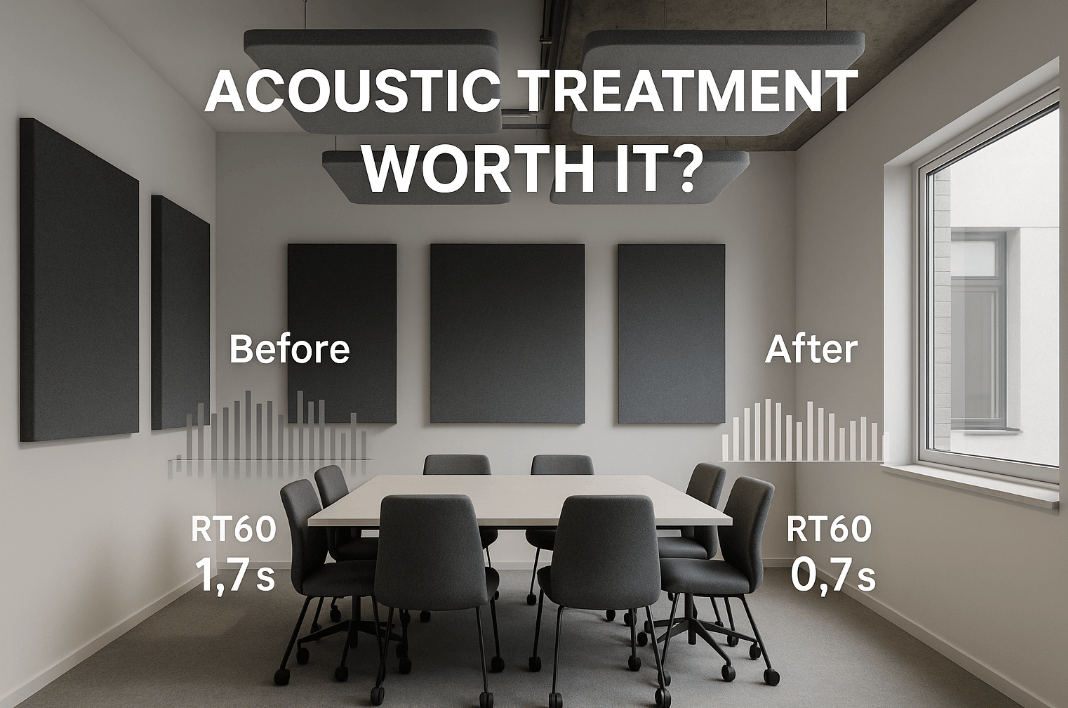Are Acoustic Treatment Sound Absorbing Panels Worth It?
Most rooms don’t sound “bad” because they leak noise; they sound bad because reflections smear clarity. Acoustic treatment sound absorbing panels reduce reverberation (RT60) and flutter echo so speech and music read cleanly. Even a 0.2–0.3 s RT60 drop is audible in offices and classrooms. For trade buyers who need consistent quality and bulk pricing, Wellco Wholesale offers factory-direct options alongside other building-adjacent supplies—useful when you’re outfitting multiple rooms without overcomplicating procurement. (Disclosure: Wellco is mentioned as one supplier option; evaluate multiple vendors to compare specs, warranty, and logistics.)
What Sound Absorbing Panels Actually Do
Acoustics 101: Reflections, Flutter Echo, and RT60
Sound bounces between parallel surfaces, creating comb filtering and the “bathroom” effect. RT60—the time for sound to decay 60 dB—summarizes room liveliness. In small speech-centric rooms, many practitioners aim for ~0.3–0.6 s depending on volume and use.
Metrics That Matter: NRC & Octave-Band Absorption
NRC compresses absorption into a 0–1 number, but octave-band data reveals where a panel works. Example (illustrative lab-type values for a 2" fabric-wrapped fiberglass panel, no air gap):
| Octave band (Hz) | 250 | 500 | 1k | 2k | 4k |
|---|---|---|---|---|---|
| Absorption (α) | 0.55 | 0.95 | 1.00 | 1.00 | 1.00 |
Use the band table on the spec sheet to match your problem frequencies; NRC ≈ 1.0 doesn’t guarantee low-mid control.
Common Panel Types & Where They Fit
-
Fabric-wrapped fiberglass/mineral wool: broadband workhorse for offices, classrooms, studios.
-
PET polyester panels: light, clean edges, printable; good for branding walls.
-
Acoustic foam: efficient above ~500 Hz; pair with thicker panels for balance.
-
Slat/lamella wood systems: absorption + gentle diffusion; design-forward spaces.
-
Clouds & baffles: both faces exposed → high absorption per square foot; ideal for tall volumes.
Field note: panels don’t “soundproof”; they shape the sound inside the room.
Are They Worth It? A Simple ROI Framework
When Panels Pay Off
-
Offices/Classrooms: modest coverage often boosts STI by ~0.1–0.2, reducing repeats and listening fatigue.
-
Hospitality/Retail: driving RT60 toward 0.7–0.9 s lowers din, improves dwell time perception.
-
Studios/Content Rooms: better mix translation and cleaner calls mean fewer revisions—direct cost savings.
When They Don’t (or Not Yet)
If the goal is isolation (keep sound in/out), you need mass, decoupling, and sealing—not just panels. Also address loud HVAC, poor room ratios, or severe low-frequency buildup (bass traps/structure).
Quick Value Test
Ask: (1) Is speech hard to understand at normal levels? (2) Do recordings sound roomy/metallic? (3) Does the space feel fatiguing above 70–75 dBA?
Two or more “yes” answers → acoustic treatment sound absorbing panels are likely worth it.
Budgeting: Costs You’ll Actually Encounter
Product vs. Project Costs
Typical ranges: panels $6–$15/ft², hardware $0.50–$2/ft², freight 10–25% of product value (palletized). Light commercial labor often adds $2–$6/ft² depending on access and ceiling work.
DIY vs Prefab vs Hybrid
-
DIY: lowest materials; trade-off is time, finish consistency, and documentation.
-
Prefab: predictable performance, clean edges, fire/VOC paperwork ready.
-
Hybrid: prefab clouds + DIY wall panels to hit a price point.
Safety & Compliance Callout
For commercial jobs, spec ASTM E84 Class A flame/smoke, absorption per ISO 354/ASTM C423, and a low-VOC statement. Confirm mounting loads, anchors, and seismic requirements where applicable.
Choosing the Right Panels for Your Space
Match Thickness/Density to the Problem
For speech clarity, 1–2" works well at first reflections; for broader control including low-mids, select 2–4" cores or add corner/boundary traps. Heavier cores extend lower—but check wall load and fasteners.
Coverage & Layout
Practical starting points: 15–25% surface coverage for offices/classrooms; 25–40% for reverberant or tall spaces. Ceiling elements often outperform wall-only coverage in open plans.
Aesthetics & Branding
Use PET or fabric-wrapped panels as brand carriers—solid colors, gradients, or print graphics—without adding glare.
Safety & Standards (Spec Check)
Your spec should list core, thickness, edge detail, fabric, test methods, flame rating, NRC + band table, and mounting hardware. No spec sheet, no buy.
Placement & Installation That Actually Works
First-Reflection Method
Sit or stand where you work; slide a mirror along walls. Wherever you can see the speaker or monitors, place a panel. Expect a smoother response and clearer imaging.
Ceiling Clouds & Baffles
In rooms with >10 ft clear height, clouds capture vertical energy that wall panels miss. Spacing clouds 4–12 in below the deck improves low-mid effectiveness.
Fasteners & Mounting
Use impalers or Z-clips for drywall, proper anchors for masonry, and cable kits/Unistrut for clouds. Track systems speed big jobs and keep seams true.
Common Mistakes to Avoid
Over-deadening, treating one wall only, ignoring corners/ceilings, and skipping pre/post measurements.
Mini Case Study + First-Hand Snapshot (E-E-A-T)
Space: 900 ft² warehouse office, exposed deck; baseline RT60 ≈ 1.7 s, STI ~0.45.
Intervention: ~35–40% coverage: 2" fabric-wrapped wall panels at reflection points + PET ceiling clouds over collaboration zone. Wall Z-clips; cloud cable kits.
Results: Post-treatment RT60 ≈ 0.7 s, STI ~0.68. Team reported clearer calls and 10–15% shorter recurring meetings.
Pre/Post snapshot (handheld app + USB measurement mic):
| Metric | Before | After |
|---|---|---|
| RT60 (avg 500–2k Hz) | 1.7 s | 0.7 s |
| STI (seated row 2) | 0.45 | 0.68 |
Anecdote: “We started by blanking the first-reflection spots with painter’s tape ‘X’ marks. Even before all clouds were up, speech ‘snap’ improved at the table—proof that placement beats sheer quantity.”
Quick Coverage Calc (Sabine) — Boxed Example
Target RT60_target = 0.6 s in a V = 230 m³ open office.
Existing average absorption A₀ = 60 m² sabins (hard surfaces).
Required total absorption: A* = 0.161 · V / RT60_target = 0.161·230/0.6 ≈ 61.7 m² sabins.
Additional absorption needed: ΔA = A* − A₀ ≈ 1.7 m² sabins (small room already fairly absorbent).
If a 2" panel averages ᾱ = 0.9 over its face, each 1 m² adds 0.9 m² sabins.
So add ~2 m² of panel face (about 22 ft²), placed at reflection points.
(Adjust for real band data, ceiling height, and furnishings.)
Expert Insight + Data Targets (E-E-A-T)
“One well-placed cloud often beats three random wall panels. Attack early reflections first; then tune the low-mids with thickness or spacing.” — acoustics practitioner, INCE Bd. Cert.
Typical target bands used by many consultants (room-size dependent):
-
Huddle room: RT60 0.3–0.5 s
-
Open office: 0.5–0.8 s
-
Classroom: 0.4–0.6 s
References you’ll see on spec sheets: ASTM E84 (flame), ISO 354 / ASTM C423 (absorption), ISO 11654 (sound absorption class), and ANSI/ASA classroom acoustics guidance.
Buying Channels & Supplier Checklist (Soft Wellco Injection)
Factory-Direct for Trade Buyers
If you’re equipping multiple locations, consolidating with a factory-direct wholesaler can cut per-room cost and simplify freight and paperwork. Wellco Wholesale supplies acoustic treatment sound absorbing panels alongside garden, farm, hospitality, and light building products—handy when your facilities team needs varied categories on a single PO.
Customization, Logistics, and Care
Specify size (e.g., 24×48 in), thickness, fabric, edge (square/bevel), print files, and mounting. Confirm MOQs, lead times, palletization, lift-gate delivery, and replacement part SKUs.
Maintenance & Warranty
-
Vacuum/brush heads per fabric maker; spot-clean with approved agents.
-
Inspect Z-clips/cables annually in public spaces.
-
Ask for a written 3–5 year workmanship warranty and fabric/color continuity statement.
10-Point Procurement Checklist
-
Room goals (RT60/STI)
-
Coverage % + layout sketch
-
Panel thickness/core
-
Fabric/color or print assets
-
Fire/VOC certificates
-
Octave-band data table
-
Mounting hardware schedule
-
Ceiling vs wall split
-
Freight & receiving plan
-
Warranty + maintenance guide
Conclusion
Are acoustic treatment sound absorbing panels worth it? Yes—when you tie them to a measurable target and put them where reflections start. Start with a quick audit, run a back-of-napkin coverage calc, and mock first-reflection spots before you buy. If you’re sourcing in bulk, request band tables, E84 and ISO reports, and a freight-inclusive quote; Wellco Wholesale can serve as one of your factory-direct benchmarks. Results vary by room; measure before and after to verify gains.
Frequently Asked Questions
1) How much coverage do I need to notice a difference?
In small offices and classrooms, 15–25% combined wall/ceiling coverage usually yields a clear, audible improvement. Taller or more reflective rooms often need 25–40% plus ceiling elements.
2) Do I need bass traps, or will 1–2" panels do it all?
For speech clarity, 1–2" at reflection points is efficient. If low-mids feel boomy (music rooms, large volumes), add 2–4" panels, air gaps, or corner traps.
3) What certifications should I ask for on commercial projects?
Request ASTM E84 Class A flame/smoke, absorption per ISO 354/ASTM C423, and a low-VOC declaration. Many jurisdictions expect these in submittals.
4) Can I install panels myself?
DIY is feasible on drywall with impalers or Z-clips. For ceilings and public spaces, use rated anchors/hardware and follow the manufacturer’s load guidance.
5) How do I keep panels looking new?
Choose durable fabrics, follow the cleaning spec, and plan periodic dust/vacuum cycles. Removable covers and rigid cores simplify maintenance over 5–10 years of service.


